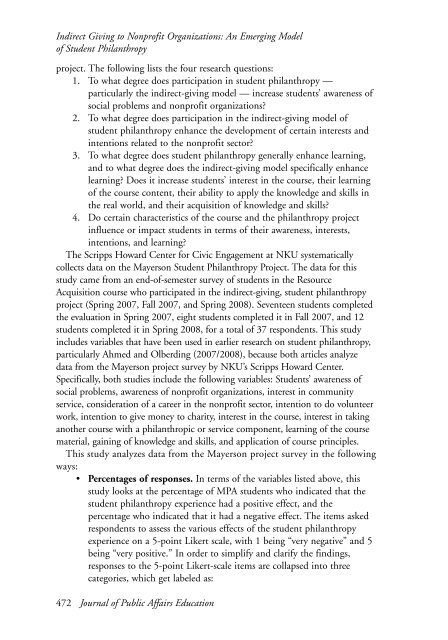JOURNAL OF PUBLIC AFFAIRS EDUCATION - National ...
JOURNAL OF PUBLIC AFFAIRS EDUCATION - National ...
JOURNAL OF PUBLIC AFFAIRS EDUCATION - National ...
You also want an ePaper? Increase the reach of your titles
YUMPU automatically turns print PDFs into web optimized ePapers that Google loves.
Indirect Giving to Nonprofit Organizations: An Emerging Model<br />
of Student Philanthropy<br />
project. The following lists the four research questions:<br />
1. To what degree does participation in student philanthropy —<br />
particularly the indirect-giving model — increase students’ awareness of<br />
social problems and nonprofit organizations?<br />
2. To what degree does participation in the indirect-giving model of<br />
student philanthropy enhance the development of certain interests and<br />
intentions related to the nonprofit sector?<br />
3. To what degree does student philanthropy generally enhance learning,<br />
and to what degree does the indirect-giving model specifically enhance<br />
learning? Does it increase students’ interest in the course, their learning<br />
of the course content, their ability to apply the knowledge and skills in<br />
the real world, and their acquisition of knowledge and skills?<br />
4. Do certain characteristics of the course and the philanthropy project<br />
influence or impact students in terms of their awareness, interests,<br />
intentions, and learning?<br />
The Scripps Howard Center for Civic Engagement at NKU systematically<br />
collects data on the Mayerson Student Philanthropy Project. The data for this<br />
study came from an end-of-semester survey of students in the Resource<br />
Acquisition course who participated in the indirect-giving, student philanthropy<br />
project (Spring 2007, Fall 2007, and Spring 2008). Seventeen students completed<br />
the evaluation in Spring 2007, eight students completed it in Fall 2007, and 12<br />
students completed it in Spring 2008, for a total of 37 respondents. This study<br />
includes variables that have been used in earlier research on student philanthropy,<br />
particularly Ahmed and Olberding (2007/2008), because both articles analyze<br />
data from the Mayerson project survey by NKU’s Scripps Howard Center.<br />
Specifically, both studies include the following variables: Students’ awareness of<br />
social problems, awareness of nonprofit organizations, interest in community<br />
service, consideration of a career in the nonprofit sector, intention to do volunteer<br />
work, intention to give money to charity, interest in the course, interest in taking<br />
another course with a philanthropic or service component, learning of the course<br />
material, gaining of knowledge and skills, and application of course principles.<br />
This study analyzes data from the Mayerson project survey in the following<br />
ways:<br />
• Percentages of responses. In terms of the variables listed above, this<br />
study looks at the percentage of MPA students who indicated that the<br />
student philanthropy experience had a positive effect, and the<br />
percentage who indicated that it had a negative effect. The items asked<br />
respondents to assess the various effects of the student philanthropy<br />
experience on a 5-point Likert scale, with 1 being “very negative” and 5<br />
being “very positive.” In order to simplify and clarify the findings,<br />
responses to the 5-point Likert-scale items are collapsed into three<br />
categories, which get labeled as:<br />
472 Journal of Public Affairs Education

















